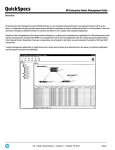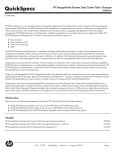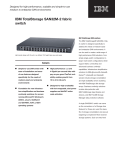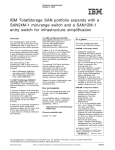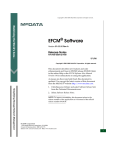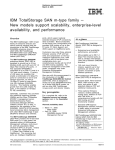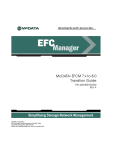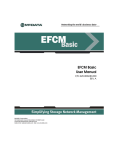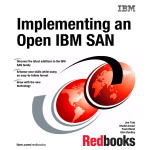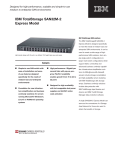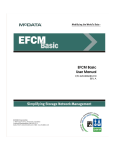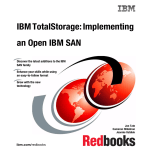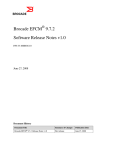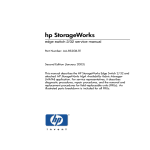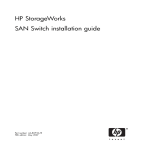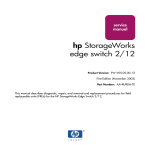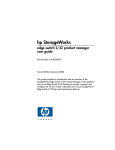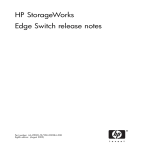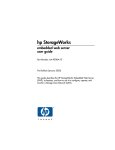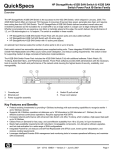Download Hp StorageWorks Director and Edge Switch release notes
Transcript
HP StorageWorks Director and Edge Switch release notes Part number: 5697-8176 Eighth edition: April 2009 Legal and notice information © Copyright 2007-2009 Hewlett-Packard Development Company, L.P. Description These release notes are intended for customers who purchased Director or Edge Switch products. The notes contain late-breaking and supplemental information for the HP M-series Director and Edge Switch products. It is important to read these notes before installing a Director or Edge Switch product. Because this information is updated periodically, HP recommends that you check the following HP website for the latest information: http://h18006.www1.hp.com/storage/networking/index.html. Update recommendation Routine Devices supported For the latest supported devices, see the HP StorageWorks SAN design reference guide, available on the following HP website: http://www.hp.com/go/SANdesignguide. Product models supported This section describes the supported switches and firmware. Switches Table 1 lists the supported switches, including the McDATA (recently acquired by Brocade) switch name and the corresponding HP switch name (if applicable). For products that have a new Brocade name, references to the McDATA name also apply to the Brocade name. Table 1 Supported switches, firmware, and software HP name McDATA/Brocade name HP StorageWorks Edge Switch 2/12 Sphereon 4300 Fabric Switch HP StorageWorks Edge Switch 2/16 Sphereon 3216 Fabric Switch HP StorageWorks Edge Switch 2/24 Sphereon 4500 Fabric Switch HP StorageWorks Edge Switch 2/32 Sphereon 3232 Fabric Switch HP StorageWorks Director 2/64 Intrepid 6064 Director HP StorageWorks Director 2/140 Intrepid 6140 Director, Brocade M6140 Director N/A Sphereon 4400 Fabric Switch, Brocade M4400 Fabric Switch Director and Edge Switch release notes 3 HP name McDATA/Brocade name N/A Sphereon 4700 Fabric Switch, Brocade M4700 Fabric Switch HAFM Basic (formerly, Embedded Web Server or EWS) EFCM Basic Edition (formerly, SANpilot) HA-Fabric Manager (HAFM) Enterprise Fabric Connectivity Manager (EFCM) Firmware Enterprise Operating System (E/OS) HAFM Appliance EFC Server Firmware 09.09.02 Firmware 09.09.02 is the latest firmware released for the HP M-series Edge Switches and Directors. This firmware is common for all M-series fabric products, except the McDATA 4-Gb SAN Switch for HP p-Class BladeSystem, which has separate firmware. The firmware is available on the following HP website: http://h18006.www1.hp.com/storage/ networking/index.html. Select Retired Products and navigate to your switch model, and then to Download drivers and software. With the release of firmware 09.09.02, version 09.06.02 is now moved to INACTIVE status. For more information on upgrading firmware versions, see the appropriate Director or Edge Switch service manual. Supported configurations Operating multiple switches in a fabric topology is subject to topology limits. Consider the impact of the following topology limits when planning the fabric: • Fabric elements—Each fabric element is defined by a unique domain ID that ranges from 1 to 31; therefore, the theoretical limit of interconnected Directors in a single fabric is 31. The supported limit of interconnected switches in a single fabric is 24. The supported limit of interconnected switches in a single fabric can be increased to 31, provided that any Edge Switch 2/16, Edge Switch 2/32, or Director 2/64 in the fabric is deployed at the edge of the fabric. However, because this is subject to change, contact your HP-authorized service representative for the current number of interconnected switches supported in a single fabric. • Heterogeneous fabric—To determine if interoperability is supported for a product, or if restrictions apply, see the product publications or contact your HP-authorized service representative. • Number of interswitch links (ISLs)—The maximum number of ISLs supported is 75% of installed ports for the Director 2/64, and 100% of installed ports for the Director 2/140. The maximum number of ISLs supported for Edge Switches is all available switch ports. For redundancy, at least two ISLs should connect any two Edge Switch or Director-class fabric elements. Because this information is subject to change, contact your HP-authorized service representative for the current number of ISLs supported for each Director or Edge Switch. • Hop count—The hop count is equal to the number of ISL connections traversed in a single path, not the total number of ISL connections between devices. The Fibre Channel theoretical limit of ISL connections traversed (hop count) in a single path through a fabric is seven. The maximum supported hop count in a single path through a fabric is three. Because this information is subject to change, contact your HP-authorized service representative for the current hop count supported by a single fabric path. 4 NOTE: For more information about planning the fabric, see the HP StorageWorks SAN design reference guide, available on the following HP website: http://www.hp.com/go/SANdesignguide. Cable requirements Consider the following switch cable requirements: • For cables measuring up to 500 meters (1 Gb/s) or 300 meters (2 Gb/s), use multimode Fibre Channel cables. For longer cables, use single-mode Fibre Channel cables. • Multimode optical cables are connected to short-wave optical transceiver modules in a switch. Single-mode optical cables are connected to long-wave optical transceiver modules in a switch. Multimode cables should use 50/125 optical fibers, and single-mode cables typically use 9/125 optical fibers for distances up to 10 km. • Verify that connectors interfacing with the Director or Edge Switch products use LC duplex connectors with a PC finish. In addition, the connector at the opposite end of the cable must be of either LC or SC type, depending on the requirements of the connected device. Operating systems For a list of supported operating systems, see the HP StorageWorks SAN design reference guide, available on the following HP website: http://www.hp.com/go/SANdesignguide. Languages English Fixes Table 2 lists issues that have been fixed since the release of firmware 09.09.00. Table 2 Fixes in this release Description Affected models A switch was blocking PLOGI accept on remote end because near end did not send SW_RSCN before PLOGI. This resulted in slow server bootup. All When Frame Redirection (FR) was used in a mixed M-series and B-series fabric, and there were Virtual Targets (VT) that were either NPIV or loop devices connected to the same physical port, and a host port was a member of two different FR zonesthat each include a Virtual Target (VT1 and VT2) on the same physical port, if the connection between the host and VT1 was interrupted, then the connection between that host and VT2 may also be interrupted. All If a port received a frame with an invalid source ID (SID), the port would not appear as a logged-in port, even though traffic was not disrupted. The Director was reporting an incorrect port status. Director 2/140 Director and Edge Switch release notes 5 Description Affected models In a FICON environment, the Director would provide an incorrect Interface Protocol Type for Node Selector 0 in response to the inband query, Read Node Identifier. Director 2/140 Due to an internal error, some switches encountered Event 411, Firmware Fault, with Fault Code 00000073. This has been corrected. All Audit log entries showed the HAFM/EFCM server IP address as 0.0.0.0 Edge Switch 2/24 Director 2/64 Compatibility and interoperability This section describes Edge Switch and Director product compatibility. HAFM/EFCM and firmware compatibility Table 3 lists the minimum version of HAFM/EFCM that can run with the various versions of firmware for the Edge Switches and Directors. Table 3 HAFM/EFCM and firmware compatibility Firmware version HAFM/EFCM version 09.07.02 EFCM 09.07.00 recommended 09.08.01 08.09.01 minimum (HAFM Appliance) 09.09.00 09.09.02 Standards compliance Table 4 lists Fibre Channel standards compliance for firmware 09.09.02. Table 4 Standards compliance Category Specific Standards Fibre Channel protocols FC-FLA FC-FG FC-GS-2 FC-GS-3 FC-GS-4 FC-MI FC-PH-2 FC-PH-3 FC-PH Rev 4.3 FC-SW-2 6 Category Specific Standards MIB-II groups Address translation Interface System ICMP IP SNMP TCP UDP Fibre Channel classes of service Class 2 Class 3 Class F Fibre Channel Element Management Information Base (MIB) FE-MIB Director and Edge Switch release notes 7 Firmware installation This section includes firmware installation information. Prerequisites for installing and using firmware 09.09.02 Consider the following prerequisites for firmware 09.09.02: • HAFM should be at the minimum level before installing the new firmware. Before upgrading to firmware 09.09.02, EFCM must be at 09.07.00 or later if you are using EFCM to manage your Directors or Edge Switches. EFCM is not required, but is recommended for managing your Directors or Edge Switches. NOTE: HAFM is not required for operating hardware products; however, it is recommended for managing your Directors or Edge Switches. • HAFM is not able to configure the McDATA 4 Gb/s Intrepid 6000 QPM (QPM) when installed into a Director 2/64. The QPM can be configured using HAFM Basic or the CLI. McDATA EFCM 9.0 or later is capable of configuring the QPM when installed into a Director 2/64. • If you are using HAFM to upgrade firmware, an Edge Switch 2/24 must be managed with HAFM 08.08.00 or higher before upgrading to firmware 08.xx.xx or later. If you upgrade to firmware 08.xx.xx or later using an HAFM release earlier than 08.08.00, the firmware upgrade may fail. Firmware 08.01.00 introduced slightly more processor utilization, which can cause the download to occasionally exceed HAFM's timeout. As an alternative to HAFM, use the switch's HAFM Basic interface (formerly EWS) to upgrade firmware. • Firmware upgrades or downgrades should not be performed using HAFM Basic from Internet Explorer 5.00.3315.1000x. If this operation is performed, the download operation may not complete and may eventually time out, leaving the switch with the previous version of firmware. • All Edge Switches and Directors in the same fabric should have the same firmware level installed. Although products can coexist in a fabric running different levels of firmware, all products must be at the same major functional release level. Upgrading from an earlier version of firmware Upgrading to firmware 09.09.02 is nondisruptive to attached devices. The Director or Edge Switch is not required to be offline before performing an upgrade operation. If there are any limitations to performing an upgrade operation, they are clearly identified. Consider the following when upgrading firmware: • Before upgrading firmware, HP recommends that you back up the Director or Edge Switch configuration. See the HP StorageWorks Director Element Manager user guide for more information. HAFM Basic also provides an option to print or save product configuration to a file. See the HAFM Basic user guide for more information. • All products must be running firmware 09.07.02 or later before upgrading to 09.09.02. If a switch is operating with a firmware level earlier than 09.07.02, you must upgrade to 09.07.02 or 09.08.01 before installing 09.09.02. • Upgrades and downgrades are supported only within a functional release, such as 09.07.02 to 09.08.01, or from one functional release to the next, such as from 09.03.00 to or from 09.06.02, or 09.06.02 to or from 09.08.01. 8 NOTE: The following HP released firmware versions are considered to be within one functional release: • 09.09.00, 09.09.02 • 09.08.01, 09.07.02 • 09.06.02 • 09.03.00, 09.02.00, 09.00.00 • 08.02.00, 08.01.01, 08.01.00 • 07.01.03, 07.01.02, 07.00.00 If HAFM Basic is used for upgrades and downgrades, and the release version rule is not followed, errors will occur and there may be a disruption to attached devices. • If upgrading firmware requires an upgrade from 04.xx.xx to 05.xx.xx in the process, there are special considerations, as described in “Upgrading firmware on a Director from 04.xx.xx to 05.xx.xx” on page 9. • If upgrading firmware requires an upgrade from 06.xx.xx in the process, upgrade from 06.xx.xx to 07.01.03. This firmware includes a fix to an issue that can occur under very specific conditions when firmware is upgraded from 06.xx.xx to 07.xx.xx . Other versions of 07.xx.xx should not be used in the upgrade process. • If upgrading firmware requires an upgrade from 07.xx.xx in the process, upgrade from 07.xx.xx to 08.02.00. Firmware 08.02.00 includes a fix to a issue that can occur when firmware is upgraded from 07.xx.xx to 08.xx.xx for the Edge Switch 2/24 and Edge Switch 2/12. Other versions of 08.xx.xx should not be used in the upgrade process. • A small number of Surestore Director FC-64 units that were shipped early may display one of the following messages during the process of upgrading to firmware 05.02.00-13: • HAFM—Firmware cannot be loaded due to insufficient CTP memory. • HAFM Basic—File System Error: Insufficient memory for new firmware version. This occurs only in certain units with CTP cards. Units with CTP2 cards do not have this issue. If you receive one of these messages during the upgrade, the firmware upgrade has failed but the unit continues to run with the existing firmware. This occurs because before activating the new firmware image, the upgrade process found there was not sufficient memory to complete. Contact HP Customer Support if you receive this message. • Some customer environments use application or host software that is affected by the restart of the Director CTP during a HotCAT download operation. Applications that rely on inband management servers are especially prone to problems caused by processor restart. For example, an application may be configured to poll the Director or Edge Switch at regular intervals. The polling process could occur during a restart period, causing the application software to react adversely. As a solution, shut down those applications driving inband requests before the upgrade, and then restart the applications after the upgrade completes. Upgrading firmware on a Director from 04.xx.xx to 05.xx.xx An issue has been identified in release 04.xx.xx if the contents of the non-volatile random access memory (NVRAM) on the active CTP are corrupted. Once the configuration has been loaded, this corruption is not detected until an IPL/IML, power cycle, or firmware code load. If the NVRAM on the active CTP has corrupted contents, the firmware load can cause the configuration to reset to factory defaults, which can cause a system outage. By using the following procedure to upgrade firmware, Director and Edge Switch release notes 9 configuration is preserved and a system outage is avoided. This issue has been resolved with firmware 05.02.00-13 and later. NOTE: You must have maintenance authorization rights to access the HAFM Product/Element Manager menu options used in this procedure. To safely upgrade firmware on a Director: 1. Upgrade HAFM software on the HAFM Server/Appliance to 07.01.00 (minimum). 2. Download firmware 05.02.00-13 by selecting Firmware Library from the Product Manager Maintenance menu. 3. Back up the Director configuration by selecting Backup & Restore Configuration from the Product Manager Maintenance menu. NOTE: Step 4 is not required if you are upgrading from 05.xx.xx or later. 4. Using the Product Manager, execute a CTP swap: a. b. c. 5. From the Product/Element Manager Hardware view, verify that an amber LED indicator is not displayed for either CTP card. Right-click the CTP card you believe to be active, and then select FRU Properties. Verify that it is the active CTP card. Right-click the active CTP card, and then select Switchover. The Director loses its Ethernet connection for a short time during the switchover process. When switchover occurs, the green LED illuminates on the backup CTP card to indicate that it is now the active card. Upgrade the firmware to 05.02.00-13 on each Director by selecting Send in the Firmware Library dialog box. Upgrading firmware on an Edge Switch from 04.xx.xx to 05.xx.xx An issue has been identified in release 04.xx.xx if the contents of the NVRAM on the CTP are corrupted. Once the configuration has been loaded, this corruption is not detected until an IPL/IML, power cycle, or firmware code load. If the NVRAM on the CTP has corrupted contents, the firmware load can cause the configuration to reset to factory defaults, which can cause a system outage. Edge Switch products already running 05.01.00 or later continually validate the NVRAM configuration, so risk of an outage is extremely low. For Edge Switch products running an earlier version of firmware, the risk of an outage increases due to the NVRAM issue. If an outage compromises system integrity, HP recommends that the Edge Switch firmware upgrade be a scheduled maintenance action that anticipates the failure of switch connectivity. This issue has been resolved with firmware 05.02.00-13 and later. To safely upgrade firmware on an Edge Switch: 1. Upgrade HAFM software on the HAFM Server/Appliance to 07.01.00 (minimum). 2. Download firmware 05.02.00-13 by selecting Firmware Library from the Product Manager Maintenance menu. 10 3. Back up the Edge Switch configuration by selecting Backup & Restore Configuration from the Product Manager Maintenance menu. 4. Upgrade the firmware to 05.02.00-13 on each Edge Switch by selecting Send in the Firmware Library dialog box. Considerations for downgrading the firmware version Directors or Edge Switches are not required to be offline before performing a firmware downgrade operation. Limitations to downgrades are clearly identified if there are any reasons for not performing the operation. Before downgrading firmware, HP recommends that you back up the Director or Edge Switch configuration. Refer to the Director or Edge Switch Element Manager user guide for more information. EWS (HAFM Basic) also provides an option to print or save product configuration to a file. See the HAFM or EFCM Basic user guide for more information. Consider the following when downgrading firmware: • All installed QPM cards must be removed from the Director 2/140 if downgrading to a version earlier than 09.00.00. All installed QPM cards must be removed from the Director 2/64 if downgrading to a version earlier than 09.01.00. • All trial PFE key features must be disabled before downgrading to a version earlier than 09.00.00. • The domain ID offset must be set to the default value of 0x60 before downgrading to versions earlier than 09.00.00. • WWN Aliases will be disabled when downgrading firmware in any Edge Switch or Sphereon switch to a release earlier than 09.01.00. • Downgrading directly to a release earlier than 09.07.00 from 09.09.02 is not allowed. To downgrade to a release earlier than 09.07.00, you must first downgrade to 09.08.01 or 09.07.02. • Upgrades and downgrades are supported only within a functional release, such as 09.07.02 to 09.08.01, or from one functional release to the next, such as from 09.03.00 to 09.06.02, or from 09.08.01 to 09.06.02. If HAFM Basic is used for upgrades and downgrades, and this rule is not followed, errors occur and there may be a disruption to attached devices. For procedures to download firmware to the Edge Switch or Director using the HAFM Element Manager interface or HAFM Basic interface, see the following: • The Edge Switch or Director installation and service manual—Provides complete procedures for obtaining firmware from the HP website and downloading firmware to the Edge Switch or Director using HAFM. • The Edge Switch or Director Element Manager online help and user guide—Provides instructions for downloading firmware to the Edge Switch or Director using the HAFM interface. • HAFM Basic user guide and online help—Provides procedures for downloading firmware to the Edge Switch or Director. Director and Edge Switch release notes 11 HAFM upgrade required for firmware 09.09.02 Consider the following HAFM requirements for firmware 09.09.02: • If you are using the 1U rack-mount HAFM Appliance to manage the Director or Edge Switch, the minimum HAFM version required is 08.09.01. This HAFM software is contained on the HP StorageWorks HA-Fabric Manager documentation and software CD (Part Number 516-000024-720). • This minimum version of HAFM allows you to manage Directors or Edge Switches running firmware 09.09.02. However, to use all of the new features and enhancements, upgrade to EFCM software 09.07.00. To migrate from HAFM to EFCM, you must first upgrade to HAFM 08.09.01. An upgrade kit to HAFM 08.09.01 is available (Part Number A7490A) for owners of a licensed version of HAFM. This HAFM upgrade is also available on the HP website http://h18006.www1.hp.com/ storage/networking/index.html. Select Retired Products and navigate to your switch model, and then to Download drivers and software. Alternatively, you can perform the firmware upgrade directly to the Director or Edge Switch using the switch's HAFM Basic management interface. Contact your local HP technical resource if you need to obtain a new HAFM version or to confirm compatibility with devices in your SAN before upgrading to this firmware. For more information on upgrading software versions, see the HP StorageWorks HA-Fabric Manager user guide. M-series and B-series switch interoperability For details on compatible firmware versions, management software EFCM or Data Center Fabric Manager (DCFM) Enterprise versions, and other requirements for M-series and B-series switch interoperability, see the latest application note under Application Notes > Fabric Interoperability, available on the HP website: http://www.hp.com/storage/spock Important information This section lists information that you should consider before using Directors or Edge Switches running firmware 09.09.02. Master log does not display port number For port offline and online messages in the Master log in HAFM or EFCM, the switch port number, switch WWN, and the connected device (Node) WWN should be included in the message. However, the switch WWN appears as the Node WWN, and the Node WWN is not included. HAFM Basic issue with Mozilla browser Access Control List (ACL) IP entries are not validated in HAFM Basic when using Mozilla browser. Default zone is disabled by default The default zone on the Director and Edge Switches is disabled by default. Zoning must be configured in order for devices connected to the Director or Edge Switch to communicate. 12 Some IP addresses must be avoided If you use HAFM to manage Edge Switches and Directors, do not use IP addresses in the range 192.168.0.0 through 192.168.0.255. This subnet is used internally by the HAFM Appliance. Using an IP address in this range causes the Call Home feature to function incorrectly. Using HAFM Basic HAFM Basic requires using Microsoft Internet Explorer version 6 or Netscape version 7 in order to operate correctly. Zoning limits Table 5 lists the supported zoning limits for the Edge Switches and Directors. Table 5 Zoning limits Zoning parameter Maximum value Number of zone members in a zone 2048 Number of zones in a zone set 1024 Number of unique zone members in a zone set 2048 Total number of zone members in a zone set (where a zone member can be in multiple zones) 4096 Characters per zoning name 32 Number of unique zone members in HAFM Zoning Library 2048 Number of zones in HAFM Zoning Library 1024 Number of zone sets in HAFM Zoning Library 64 Number of end ports 2048 Number of devices supported (including loop devices) 2048 Using the same firmware level All Edge Switches and Directors in the same fabric should have the same firmware level installed to ensure that this firmware operates correctly. Firmware 09.09.02 is common for all M-series fabric products, except the McDATA 4-Gb SAN Switch for HP p-Class BladeSystem, which has a separate firmware. Reinstalling feature licenses Feature licenses (or keys) must be reinstalled after performing a factory reset on an Edge Switch or Director to regain use of the licensed features (for example, SANtegrity Binding). Director and Edge Switch release notes 13 CTP controls port lights Port lights on the Edge Switches and Directors are controlled by the CTP. Certain activities such as firmware updates, IPLing the CTP, or switching over to the backup CTP (Director) can cause these port lights to extinguish momentarily until control is reasserted by the CTP. The actual Fibre Channel traffic is not affected during these times. Full-fabric capability for Edge Switch 2/12 Unlike other Edge Switch and Director products, a PFE key controls Edge Switch 2/12 E_Port-to-E_Port connections. After purchasing and installing the feature key, you can configure for E_Port connections on any of the active ports. The feature key includes distance support. With firmware 06.00.00 and later, the Edge Switch 2/12 ships with five BB_Credits allocated to each port. After activation of the Full Fabric feature on a switch, each port has 12 BB_Credits allocated to support up to 12-km links at 2-Gb/s speed. Support for speed Auto-Negotiate Auto-negotiate is supported. However, HP recommends that the port speed for E_Ports (for ISLs) be set to a specific port speed (1Gb/sec, 2Gb/sec, or 4Gb/sec, as appropriate for the speed of the Directors or Edge Switches being connected) instead of to Negotiate. Using a specific port speed decreases the time required for a fabric build in response to some perturbation in the fabric. Similarly, setting a specific port speed for N_Ports also decreases fabric build time. However, setting a specific port speed for N_Ports is not required. There are some older HBA devices that do not always succeed in logging in to a switch port when the port speed is set for auto-negotiate. Workaround If an older HBA has difficulty logging into a switch port that has its port speed configured as Negotiate, configure that port speed to 1Gb/sec, 2Gb/sec, or 4Gb/sec, according to the operating speed of the HBA connected to that port. SNMP object returns incorrect value SNMP object t11NsInfoSubsetTableLastChange object does not return the proper value of the last change in the Name Server timestamp, but instead always returns the value “0 days 00h:00m:00s.00th”. Preferred Path may be cleared when a port card is replaced When replacing a port card module, a configured Preferred Path with a source port that is part of the newly installed port card module is cleared, while a configured Preferred Path with an exit port that is part of the newly installed port card module is not cleared. If the Preferred Path entry is cleared when a port card module is replaced, the Preferred Path must be reentered. 14 Devices in a mixed fabric may not login after power cycle if RD Zones are configured In a mixed fabric (containing both M-series and B-series switches) in McDATA Fabric interop mode, devices will be prevented from logging in to a switch or director that is Power On Recycled (POR) when RD Zones are configured. This is evident when the name server database is empty and the F_Ports do not come online. To allow the devices to login, either execute cfgsave from a B-series switch in the fabric, or delete the RD zones locally using the CLI. A fabric initialization error may occur A Fabric Init error may occur when a two-switch fabric has only one ISL between them, and the ISL is blocked and unblocked. When this occurs, the fabric is not formed. This can be corrected by setting one of the switches offline and then back online. This is disruptive to devices connected to the switch that is set offline, and should be planned for accordingly. Segmented ISL may be reported incorrectly in a mixed fabric B-series switches display a Gx_ Port connection as Loopback (when they should display a segmented condition) for M-series Edge Switch 2/24 or McDATA Sphereon 4500, M4700, or M4400. To avoid this, configure the port as a G_Port and not a Gx_Port when attaching to a B-series switch. Director and Edge Switch release notes 15 Known issues in firmware 09.09.02 Table 6 lists the known issues in firmware 09.09.02. Table 6 Firmware 09.09.02 known issues Issue Workaround If a switch has been managed with HAFM/EFCM Management Style configured to FICON Management Style, and the Prohibit Dynamic Connectivity Matrix (PDCM) has been configured with Active=Saved disabled, and the HAFM/EFCM Management Style is changed to Open Systems Management Style, and the switch is power cycled, when the switch power on reset is executed, the PDCM configuration is set to the previously active configuration instead of the configuration of the contained in the IPL file. If the switch has been configured as described, review and modify the PDCM as needed after a power cycle. If Frame Redirection (FR) zones are being used with M-EOS switches and directors and there are FR zones loaded on all switches in the fabric, FR zones will be lost on the M-EOS switches and directors upon power cycle. When this happens, any device that attempts to log in on any port will have the port it uses blocked (via Event #012: “Redirect Zones database no longer intact. Blocking all N-ports.”) Two workarounds can be used: 1. If the switches are still in a fabric with FR zones activated, perform the CLI “cfgsave” command on any Brocade switch running FOS. This will push the FR zones to all M-EOS switches and directors in the fabric. 2. If the switches are no longer in a fabric with FR zones activated, run the CLI command “disableSplZoneSet” on each M-EOS switch or director that was power cycled to clear the invalid FR zone database. After completing either of these two workarounds, any port with an attached device that was blocked will become unblocked. The device will then be allowed to login. After upgrading firmware from 9.6.x or later, rarely the Ethernet port may become unresponsive, which prohibits management of the switch. If this issue is encountered, the Ethernet port may recover by removing and reconnecting the Ethernet cable from the port. If this does not work, you can execute an IML by momentarily pushing the IML button on the switch, which will reset the Ethernet port. When Open Trunking is in use and Reroute Delay is enabled, and traffic is rerouted by the Open Trunking function, the anticipated changes in data flow are not correctly accounted for in the Open Trunking algorithms. This can cause delays in rerouting traffic by the Open Trunking function. The slower rerouting of data by Open Trunking can be tolerated and will correct itself. This can be avoided by disabling Reroute Delay when using Open Trunking. When firmware is upgraded or downgraded between versions 9.6.2 and 9.8 in an M4700 switch using EFCM, an Event #411 Firmware Fault may be reported in the Event Log. The switch will recover from this automatically, and the event can be disregarded. 16 Determining current firmware version This section describes how to determine the current version of firmware for an Edge Switch or Director using HAFM, HAFM Basic, Embedded Web Server, or the CLI. Using HAFM To determine the current version using HAFM: 1. 2. Open the Element Manager for the Edge Switch or Director. Select Product > Properties from the menu bar. The firmware version appears in the dialog box. Using HAFM Basic To determine the current version using HAFM Basic (firmware 08.xx.xx or later): 1. Using the IP address of the switch, log in to the Edge Switch or Director through a web browser. The Fabric View appears. 2. Click Details for the Edge Switch or Director. The Product > Hardware view appears, displaying the firmware version. Using Embedded Web Server To determine the current version using Embedded Web Server (firmware 07.xx.xx or earlier): 1. 2. 3. Using the IP address of the switch, log in to the Edge Switch or Director through a web browser. Select View from the navigation panel on the left. Select the Unit Properties tab. The firmware version appears in tab. Using the CLI To determine the current version using the CLI: 1. 2. Telnet to the Edge Switch or Director using the IP address of the switch. Enter the show system command. The firmware version appears in the system information display. Supersedes history This version supersedes firmware 09.09.00. Effective date April 2009 Director and Edge Switch release notes 17 18


















